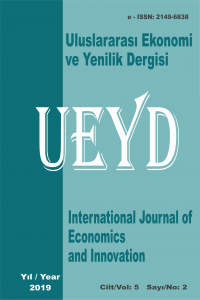Konut Talebine göre Benzer Özellik Gösteren Türkiye İllerinin Panel Veri Kümeleme Analizi ile Belirlenmesi
Abstract
Bu çalışmanın temel
amacı uygun kümeleme yöntemi ile Türkiye’nin konut talebinde benzer özellik
gösteren illerini belirlemektir. Bu amaç doğrultusunda, 2008-2015 yılları
arasında Türkiye illerinin konut talebi ve konut talebini etkileyen ekonomik
faktörleri ele alınarak panel veri seti oluşturulmuştur. Ele alınan panel veri
setine, Öklid, Gower ve K-prototip uzaklıkları kullanılarak toplamsal
hiyerarşik kümeleme yöntemleri (Average, Complete, Ward, Single ve WPGMA) uygulanmıştır.
Kümeleme yöntemlerinin Cophenetic korelasyon katsayısı hesaplanarak uzaklıklar
için uygun kümeleme yöntemleri belirlenmiştir. Belirlenen kümeleme
yöntemlerinin küme geçerlilik (Dunn, Silhouette ve Connectivity) indeks
değerleri hesaplanmıştır. İndeks değerlerine göre, veri seti için Öklid
uzaklığı kullanılarak yapılan WPGMA kümeleme yönteminin uygun olduğu tespit
edilmiştir. WPGMA yönteminin kümeleme sonucuna göre Türkiye’nin konut talebinde
benzer özellik gösteren illeri belirlenmiştir.
Keywords
References
- Akay, Ö. ve Yüksel, G. (2018). Clustering the mixed panel dataset using Gower's distance and k-prototypes algorithms. Communications in Statistics-Simulation and Computation, 47(10), 3031-3041.
- Akay, Ö. ve Yüksel, G. (2019). Hierarchical clustering of mixed variable panel data based on new distance. Communications in Statistics-Simulation and Computation, 1-16.
- Bajari, P. ve Kahn, M. E. (2005). Estimating housing demand with an application to explaining racial segregation in cities. Journal of business & economic statistics, 23(1), 20-33.
- Bourdieu, P. ve Wacquant, J. D. (1992). An invitation to reflexive sociology. Chicago: Chicago University Press.
- Çelik, C. ve Kıral, G. (2018). Kümeleme yöntemiyle konut talebinin incelenmesi: Türkiye il grupları üzerine bir uygulama. Çukurova Üniversitesi Sosyal Bilimler Enstitüsü Dergisi, 27(1), 123-138.
- Çelik, C. ve Kıral, G. Yurtdışı Yerleşiklerin ve Dış Ülkelerin Konut Taleplerini İncelemede Panel Kümeleme Analizi: Türkiye İlleri Örneği, Çukurova Üniversitesi İktisadi ve İdari Bilimler Fakültesi Dergisi, 22(2), 305-324.
- Daşkıran, F. (2015). Denizli Kentinde Konut Talebine Etki Eden Faktörlerin Hedonik Fiyatlandırma Modeli ile Tahmin Edilmesi. Journal of International Social Research, 8(37).
- Donaldson, C. ve Gerard, K. (1998). Economics of health care financing (Rev.ed.). Macmillan Press Ltd.
- Goodman, A. C. (1990). Demographics of individual housing demand. Regional Science and Urban Economics, 20(1), 83-102.
- Goodman, A. C. ve Kawai, M. (1982). Permanent income, hedonic prices, and demand for housing: New evidence. Journal of Urban Economics, 12(2), 214-237.
- Green, R. ve Hendershott, P. H. (1996). Age, housing demand, and real house prices. Regional Science and Urban Economics, 26(5), 465-480.
- Gujarati, D. (2016). Örneklerle ekonometri. (N. Bolatoğlu. Çev.). Ankara: BB101 Yayınları.
- Güriş, S., Çağlayan, E. ve Ün, T. (2011). Estimating of Probability of Homeownership in Rural and Urban Areas: Logit, Probit and Gompit Model. European Journal of Social Sciences, 21(3), 405-411.
- Ioannides, Y. M. ve Zabel, J. E. (2003). Neighbourhood effects and housing demand. Journal of applied Econometrics, 18(5), 563-584.
- Jud, G. D. ve Frew, J. (1986). Real estate brokers, housing prices, and the demand for housing. Urban Studies, 23(1), 21-31.
- Lu, H. ve Huang, S. (2011). Clustering Panel Data. SIAM International Workshop on Data Mining held in conjunction with the 2011 SIAM International Conference on Data Mining. 1-10.
- Quigley, J. M. (1976). Housing demand in the short run: An analysis of polytomous choice. In Explorations in Economic Research, 3(1),76-102.
- Rapaport, C. (1997). Housing demand and community choice: an empirical analysis. Journal of Urban Economics, 42(2), 243-260.
- Zheng, B. ve Li, S. (2014). Multivariable panel data cluster analysis and its application. Computer Modeling & New Technologies, 18(1), 553-557.
Details
| Primary Language | Turkish |
|---|---|
| Subjects | Economics |
| Journal Section | Research Articles |
| Authors | |
| Publication Date | October 24, 2019 |
| Submission Date | June 24, 2019 |
| Published in Issue | Year 2019 Volume: 5 Issue: 2 |
Cited By
Konut Fiyatları Tahmininde Makine Öğrenmesi Sınıflandırma Algoritmalarının Kullanılması: Kütahya Kent Merkezi Örneği
Dumlupınar Üniversitesi Sosyal Bilimler Dergisi
https://doi.org/10.51290/dpusbe.1249461
International Journal of Economics and Innovation

